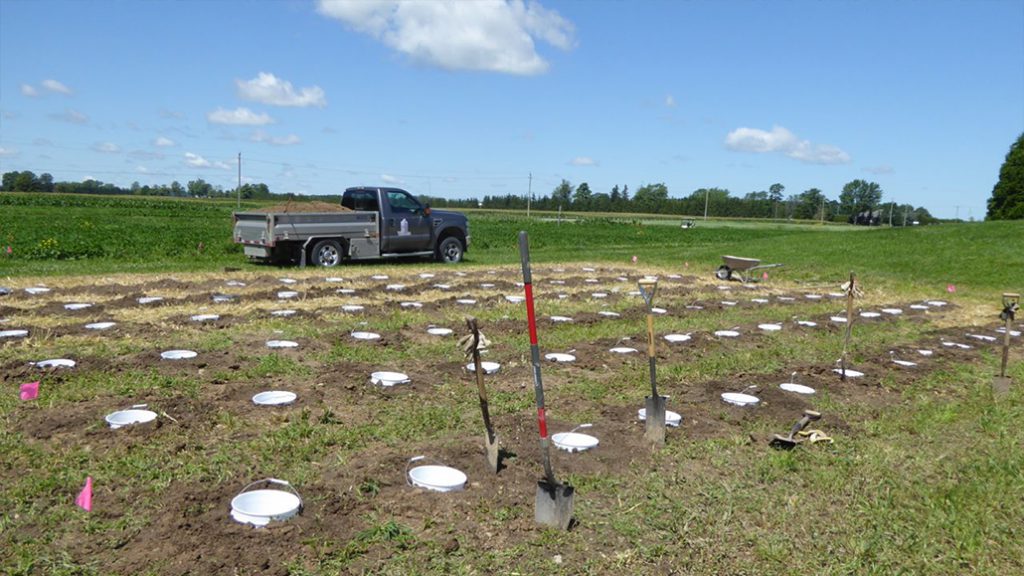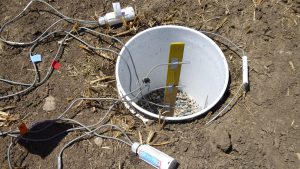Western bean cutworm
OVERWINTERING BEHAVIOUR AND BIOLOGY

IN THE SPACE of five seasons, the Western bean cutworm (WBC) has spread to become a well-established threat across Ontario. The question is, how?
Researchers from the University of Western Ontario (UWO) are trying to understand more about the pest’s overwintering habits and basic biology so they can give farmers a better idea of what conditions allow WBC to reproduce, spread, and overwinter.
“I understand farmers’ frustration. They want an answer right now and I don’t blame them,” says Professor Jeremy McNeil, from UWO’s Department of Biology. “But some of those answers can’t be instantly generated, because we don’t know much about Western bean cutworm. With further information, we may be able to improve on the current management strategies.”
Currently, pheromone traps are used to monitor for WBC moths in corn fields and detect when the peak moth flight takes place. Farmers then monitor their crops for egg masses and spray once a certain threshold is reached.
“We would like to relate the number of moths caught to the number of egg masses or larvae found in the field,” says McNeil. “And if you could say ‘above this number of moths caught per day, per week, in the trap means we’re going to have more caterpillars and intervention is needed.’”
However, there doesn’t always seem to be a strong relationship between what’s caught in the trap and subsequent WBC feeding damage.
One key aspect, says McNeil, lies in understanding where many of these cutworms are coming from. Are there big WBC populations overwintering in local fields, or are the pests flying in from warmer geographies?
This is where knowing more about WBC overwintering and biology could allow researchers to develop a sort of early warning system for major infestations.
“We know there are certain species of insects that don’t overwinter here, but immigrate in every year,” explains McNeil. “And in some years, these insects can cause epidemics if we get a very large population, and if the conditions are ideal for them when they get here.”
He compares getting a serious insect epidemic to rolling three dice at a casino and getting three sixes. The first six, McNeil says, represents the conditions wherever the insects are coming from, which need to be ideal to have a big population.
The second six is the weather patterns that will carry insect pests, like WBC, into Ontario growing areas, while the third six represents the weather and growing conditions when the WBC arrives in Ontario.
“You might have had a freezing cold spring where nothing’s been planted,” says McNeil. “In that situation, even if hundreds of Western bean cutworm moths arrived every minute, they would all die.”
| MANAGEMENT STRATEGIES Bt-corn
Insecticides
Insecticides and Fungicides
Reprinted from June/July 2017 issue of Ontario Grain Farmer, provided by Tracey Baute, Art Schaasfma, and Jocelyn Smith. |
OVERWINTERING
But even if immigrant cutworm populations were out of the picture, farmers may need to be worried about local, overwintering WBC.
That’s why McNeil and his research team are trying to learn more about the WBC’s overwintering biology — namely how soil depths, temperatures, and timing affect the insects’ survival rates when they burrow down into the soil as pre-pupae.
“We do know that there’s only one generation of WBC a year, but they start early. The first moths that lay eggs and the last ones that lay eggs can be nearly a month apart,” he explains. “So, you could have some going into the soil in mid-August with others in late September.”
This is important, as insects use day-length and temperatures as a cue to overwinter. But higher late-season temperatures in September could be causing a much wider overwintering period. McNeil is also working with UWO biology professor Brent Sinclair and graduate student Kurtis Turnbull to understand how much energy the pest uses while overwintering.
“One of the big questions for us is, do WBC have enough energy to survive and emerge as adults,” he says.
McNeil points out that the insects are also cold blooded, so if the soil is cool with a snow cover, the WBC pre-pupae use far less energy while overwintering. But the warmer soil temperatures are, the faster they use up energy meant to last them through the following spring.

McNeil and his fellow researchers suspect that climate change and weather conditions could play a big role in cutworm survivability. This led them to set up a field trial at their experimental farm outside of London, where pre-pupal cutworm larvae were buried in cages about one meter deep in the soil.
The idea, explains McNeil, is to infest corn plots with the pest, then dig up some of the cages in September, November, and March to see how many insects have survived until the spring. The researchers also look closely at each cutworm’s fat content to see how much energy the insects have used up while underground.
So far, McNeil and his fellow researchers found that 50 to 65 per cent of pre-pupae cutworm larvae died by the end of September — roughly one month after burrowing underground.
“Of course, that doesn’t bode well for the insect’s long-term survival until the following June – especially when they need to survive in the soil for eight-and-a-half months,” explains McNeil.
What their findings suggest is that an important portion of the cutworm populations infesting Ontario fields are being blown in from other areas.
EMERGENCE
However, if there is a local population of overwintering WBC — when they emerge relative to the immigrant population will determine which of these two populations farmers need to be most concerned about.
“Let’s say the immigrants arrive first, and we have an early spring that lets farmers plant their corn and beans. If the immigrants come in and the corn has grown to a certain level that’s right for them, they will be a much more important threat than the local populations that emerge later,” explains McNeil.
On the flip side, if spring conditions are poor and the corn isn’t in the right stage, the early-arriving immigrant populations may not be as significant an issue, but later-emerging local cutworms may pose a threat.
“If there is a significant local population, we want to find out how important is it each year. And if it’s big enough, what years will the local population be more of a threat than the immigrant population relative to the corn’s stage in development?” says McNeil.
He adds that understanding more about WBC biology is a long-term project, but one that makes it more likely researchers will be able to suggest more effective scouting and management methods.
“I’m not promising any silver bullets here, and even if we learn everything there is to know about Western bean cutworm, it doesn’t necessarily guarantee a total win. But we should be able to improve things,” he says.
This project was funded in part through Growing Forward 2 (GF2), a federal-provincial initiative. The Agricultural Adaptation Council assists in the delivery of GF2 in Ontario. •























